What Are the Best Air Purifying Indoor Plants for the Home?
Last Updated: August 20th, 2021
Do you know that the indoor air you breathe contains several toxins, dust particles, and germs? This air pollution is responsible for many airborne diseases and allergies. Have you heard about air purifying indoor plants? Do house plants really purify the air of your home? Or is it a myth? Let’s explain it with scientific evidence.
In 1989, NASA made a study stating that many air-purifying plants can reduce indoor air pollutants such as volatile organic solvents and other toxins. After this study, people started lining up their window sills with greenery. Recent researchpublished in 2019 shows that NASA’s studies were based on experiments on plants in the sealed containers. In contrast, you can’t expect the same result from the plants indoors. You have to place 10-1000 plants per square meter of the building floor to achieve purified room air.
Indoor air purifying plants have a lot of benefits. They can clean some of the air you breathe, if not all of it. They give you a fresh feeling and help you cope with mental illnesses such as depression and anxiety. Moreover, they help reduce stress levels and improve mood swings. Let’s jump in to find the details of some of the best air-purifying plants for your home.
1. Spider Plant
(Chlorophytum Comosum)
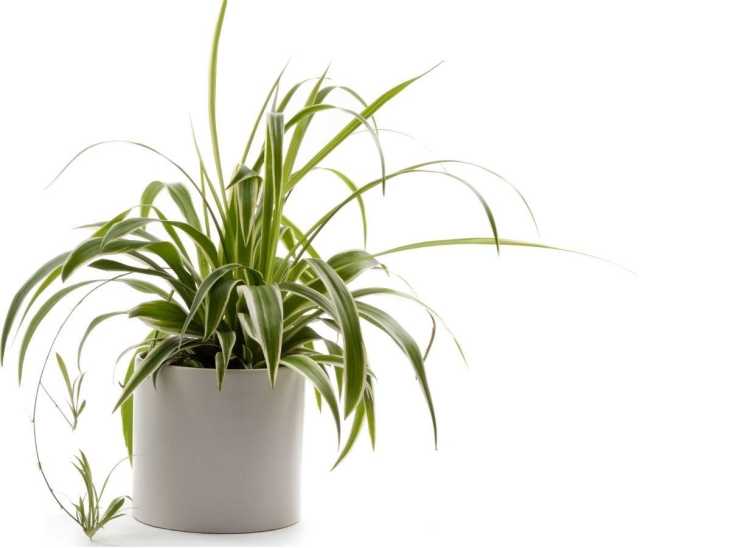
It is one of the easiest to grow indoor plants that require minimum care. Its long and narrow leaves make an eye-catching display when placed in the center of the table or the hanging baskets. It produces tiny spiderettes. These baby plants can be separated and rooted as individual plants.
How to care for it: Spider plants are incredibly resilient. Water once a week during summer and spring. Allow the soil to dry between watering during the winter season.
Make sure to use rainwater or distilled water since spider plants are sensitive to fluorides present in tap water. Use a balanced houseplant fertilizer every two to three weeks. Watch this video to find how to care for spider plants.
Filters Toxins: Spider plants have air-purifying properties. They filter toxins such as benzene, xylene, toluene, carbon monoxide, formaldehyde, styrene.
Pet Toxicity: These are non-toxic to pets.
Placement: Hang the plant near the window where it can receive indirect sunlight. Or a room with moderate light and temperature is an ideal spot for placing spider plants. During winters, the indoor heating system dries out the air. So place the plants in the kitchen or bathroom where they can get enough humidity.
Where to Purchase It: You can purchase it online from Etsy, Amazon, local houseplant stores, garden goods.
2. Golden Pothos or Devil’s Ivy
( Epipremnum Aureum)
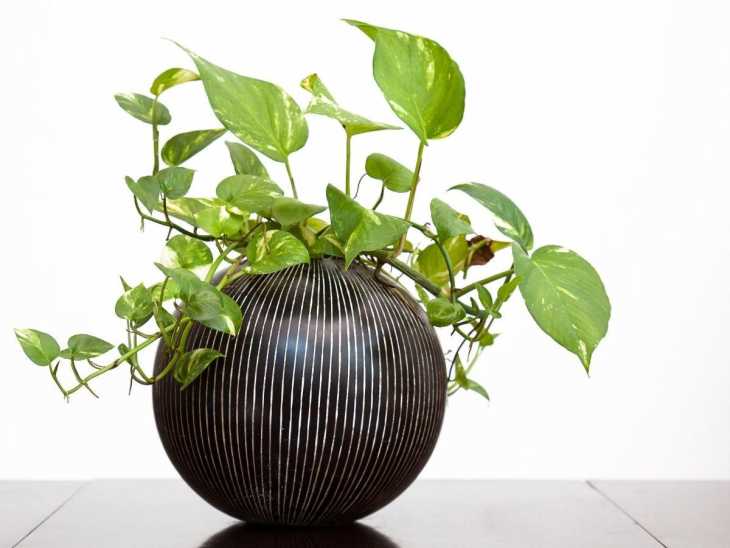
Golden pothos is a hard-to-kill indoor plant that also cleans the air. It has heart-shaped green leaves with yellow variegation. It can trail and grows up to 8 feet tall. Even if you don’t have much time for its care, this one is ideal to consider. It reduces indoor air pollution by absorbing gaseous toxins.
Care Guide: Water the plants once a week during summer and spring. Allow the soil to dry between watering. During winter, water only when the soil is dry.
It prefers bright indirect light. It can tolerate 3 to 4 hours of direct sunlight but longer exposure can burn the foliage. Check out this video about how to care for Golden Pothos.
Filter Toxins: Carbon monoxide, xylene, formaldehyde, benzene, toluene, trichloroethylene.
Pet Toxicity: Toxic to pets. Keep away from cats and dogs.
Placement: Place it near the window where it can receive bright indirect light.
Where to purchase it: You can buy it from Amazon, Etsy,Home Depot, and house plant nurseries.
3. Chinese Evergreen or Aglaonema
(Aglaonema)
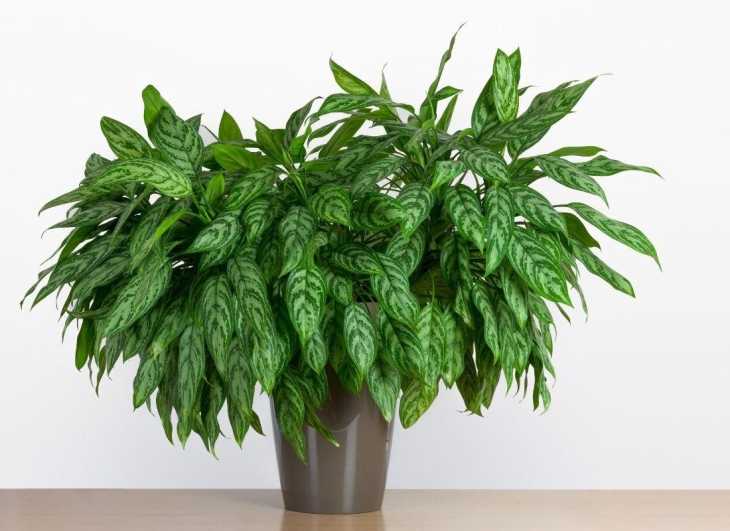
Aglaonema is one of the best air purifying indoor plants. Though it requires some extra care, it is an effective cleanser of air pollutants present in detergents and cosmetics. The attractive leathery leaves of this houseplant show an eye catchy display. Moreover, it helps in mood-boosting and stress reduction.
Care Guide: It prefers well-drained soil and humid conditions. Keep the soil moist by misting. Water once a week is sufficient. Reduce the watering frequency in winters.
Fertilize with diluted liquid houseplant fertilizer from spring to summer. It requires re-potting once every two to three years in spring. Watch this video to explore the care guide of Aglaonema.
Chinese evergreen has low light tolerance. It thrives well when placed away from direct sunlight.
Filter Toxins: Formaldehyde, benzene, carbon monoxide, trichloroethylene.
Pet Toxicity: It is toxic to dogs and cats.
Placement: It is a moisture-loving and warmth-loving plant. You can place it in the kitchen and bathroom. Or in any room with a temperature between 15 to 27 degrees Celsius.
Where To Buy It: You can get it from Walmart, Amazon, Etsy.
4. Areca Palm
(Dypsis Lutescens)
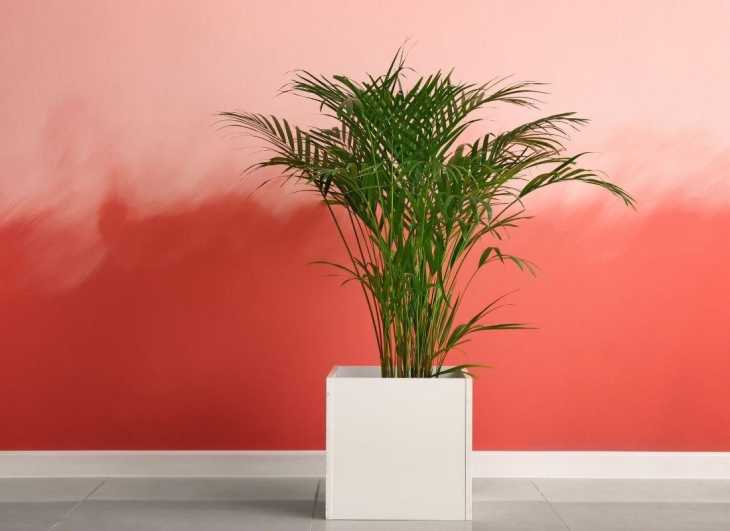
Areca palm cleans the air and acts as a natural humidifier by releasing moisture indoors. It is native to Madagascar. Its other name is butterfly palm. It is one of the best air-purifying plants that is also pet friendly. In addition, Its big, bold fronds add charm and grace when placed in any of your rooms.
Care Guide: It grows well when placed near the south or west-facing window. Also, it prefers a well-drained peat-based potting mix.
Areca palm is a moisture-loving plant. So, keep the soil moist but not waterlogged. Allow the potting mix to slightly dry before watering. It does best at average room temperature.
Fertilize the plant once a month from spring to summer. However, avoid watering in winters during the dormant state. Watch out for this care guide video.
Toxin Removal: Toluene, Benzene, Formaldehyde.
Pet Toxicity: Non-toxic to pets.
Placement: It looks nice when placed near the south-facing or west-facing window.
Where to Buy it: Amazon, Etsy, Walmart.
5. Aloe Vera
(Aloe Barbadensis Miller)
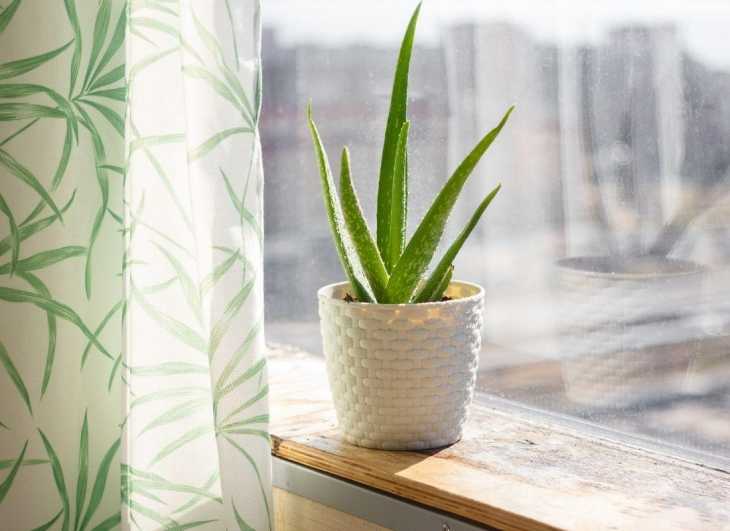
Aloe vera plant is an ideal choice for cleaning the indoor air. In addition to air purifying properties, it has amazing health benefits. It heals sunburn and wounds. It absorbs the volatile organic compounds found in cleaning products from the indoor air.
Care Guide: Aloe vera loves a sunny spot in your home. But prolonged sun exposure can turn its leaves yellow. So, place it in a bright location away from the direct sunlight. Here’s an aloe vera care guide video.
Being succulent, it thrives in a well-drained potting mix. Water when the topsoil becomes dry. Avoid over-watering.
Fertilize with house plant liquid fertilizer once a month during spring and summer.
Re-pot the baby plants produced by matured aloe vera mother plants.
Filter Toxins: Formaldehyde, Benzene, Carbon monoxide.
Pet Toxicity: Mild to moderate levels of pet toxicity.
Placement: Place it near the south-facing or west-facing window where it can receive the bright indirect light.
Where To Buy It: Amazon, Etsy, Walmart, Garden Goods, local plant nurseries.
6. Chrysanthemum
(Mums)
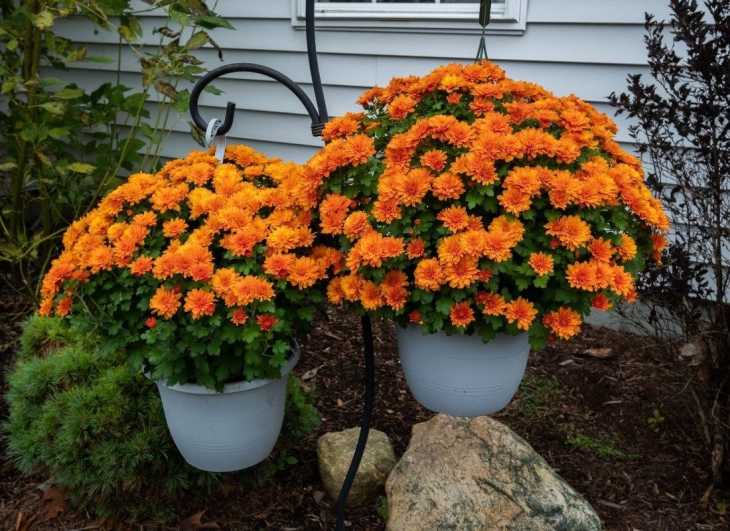
If you want to add brightness to your home in addition to cleaning the air, chrysanthemum is the best choice for indoor plants. Its colorful blooms look graceful wherever you place them. Also, it puts a stress-relieving effect on your mood. Its vibrant blooms range in color from yellow, red, purple, lavender, and orange.
Care Guide: Plant Chrysanthemum in well-drained potting soil. Keep the soil moist but not soggy during summer and spring. Reduce watering frequency during winters and allow the soil to dry between watering intervals.
Place the plants indoors where they can receive 4 to 5 hours of bright indirect light. These plants are phototropic; it means they depend on photoperiod to trigger blooming. You can induce blooming in mums by reducing the amount of light they receive.
Mums are heavy feeders. So, fertilize these plants by diluting liquid houseplant fertilizer during spring and the start of summer. Check out this video for caring for chrysanthemums indoors.
Removes Toxins: Formaldehyde, Benzene, Trichloroethylene.
Pet Toxicity: Toxic to pets such as cats, dogs, and horses.
Placement: Select a spot for mums that receive bright indirect light. It can be a kitchen or a living room window.
Where to buy it: Etsy.
7. Corn Plant
(Dracaena Fragrans)
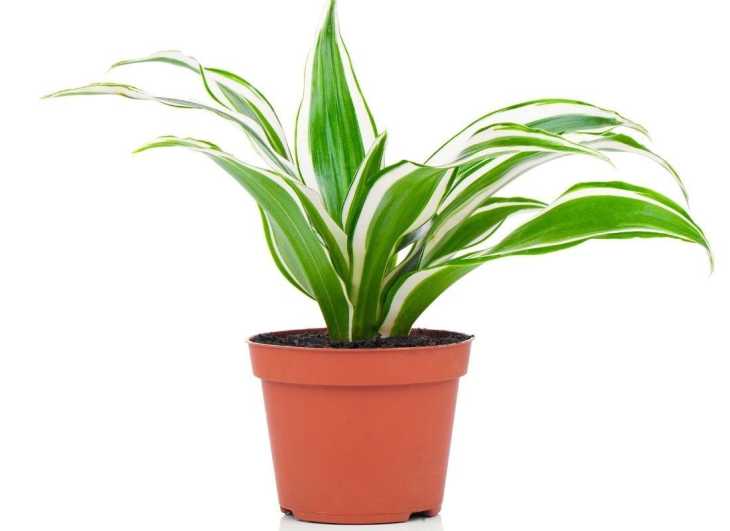
The corn plant is one of the best indoor plants that not only purify the air but also look appealing.
Care Guide: It needs medium to bright indirect sunlight to thrive. Make sure that the upper layer of soil is dry between watering intervals. The indoor temperature should be between 65 to 75 degrees Fahrenheit. Here’s a corn plant care guide video, check it out.
Removes Toxins: Carbon dioxide, Benzene, Formaldehyde, trichloroethylene.
Pet Toxicity: Toxic to pets.
Placement: Place it close to the south-facing or west-facing window.
Where to buy it: Amazon, Walmart.
8. Gerbera Daisy (Barberton Daisy)
(Gerbera)
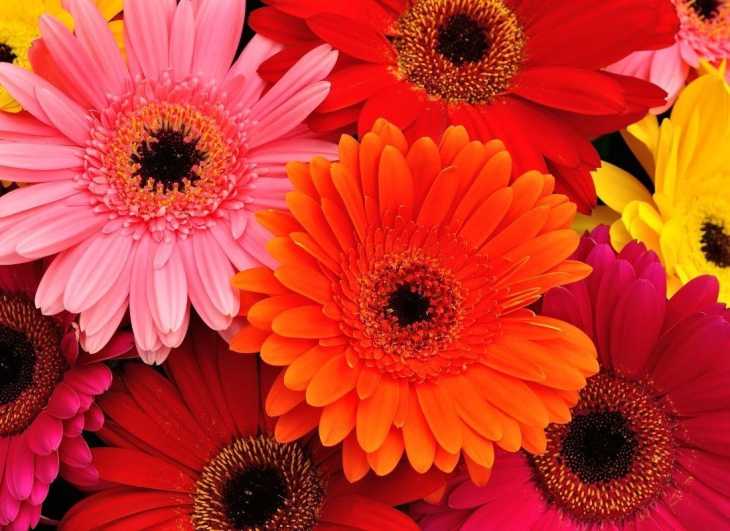
The vibrant colorful blooms of the gerbera daisy give a lively touch to your indoors. Also, it freshens the indoor air.
Care Guide: These daisies are sun-loving and need direct sunlight exposure to stay alive. Water in the morning and allow the soil to dry before re-watering. Here’s a Gerbera daisy care video.
Trimming is crucial for triggering new bloom production. Fertilize with micronutrient-rich plant fertilizer once a month during the growing season.
Removes Toxins: Benzene, Formaldehyde, Trichloroethylene.
Pet Toxicity: Non-toxic to cats, dogs, and horses.
Placement: Best to place at a south-facing window where it can receive maximum direct sunlight.
Where to buy it: Walmart, Amazon.
9. Scarlet Star Bromeliad
(Guzmania Lingulata)
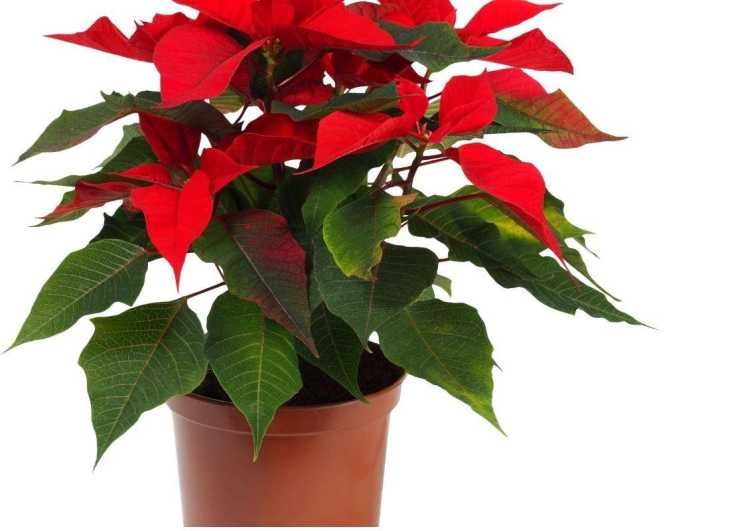
Scarlet Star is a quick air purifier indoor plant in recent research. It absorbs 80% of the volatile organic solvents in just 12 hours according to recent research.
Care Guide: Scarlet Star bromeliad grows well in humid conditions. Moreover, it prefers bright indirect light to thrive. Water deeply once a week and let the topsoil dry before the next watering. Check out this Bromeliad care video.
Removes Toxins: Benzene, ammonia, formaldehyde.
Pet Toxicity: Non-toxic to pets.
Placement: Place it in humid environments such as bathrooms.
Where to buy it: Walmart
10. White Jewel
(Dracaena Warneckii)
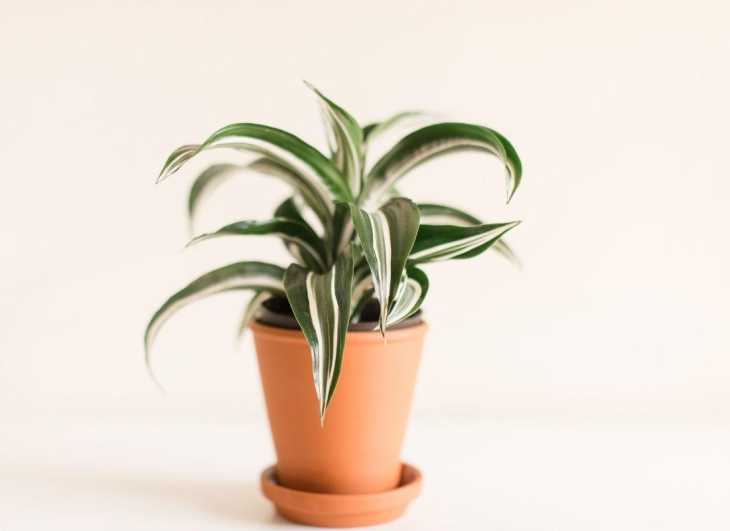
White jewel is an excellent choice if you aim to give a therapeutic touch to your indoors. It is known to boost your memory and attention span in addition to absorbing air pollutants from your home.
Care Guide: Dracaena needs indirect sunlight to thrive. Also, it needs less water as compared to other plants. So, keep misting the leaves and let the soil dry completely before you water it again. Watch out for this Dracaena warneckii care video.
Absorb Toxins: Formaldehyde, xylene, benzene, trichloroethylene.
Pet Toxicity: Toxic to pets such as cats, dogs, horses, and even humans.
Placement: Place it in the corners of the room, or center table.
Where to purchase it: Etsy, Walmart.
11. Conclusion
All of the mentioned houseplant types are among the best air-purifying indoor plants. They inhale toxic gases and exhale filtered air that adds freshness to your indoors. Moreover, all of these indoor plants are therapeutic in improving your overall mood. So, why not infuse your indoors with a variety of plants that not only fight air pollutants but also require minimum care.